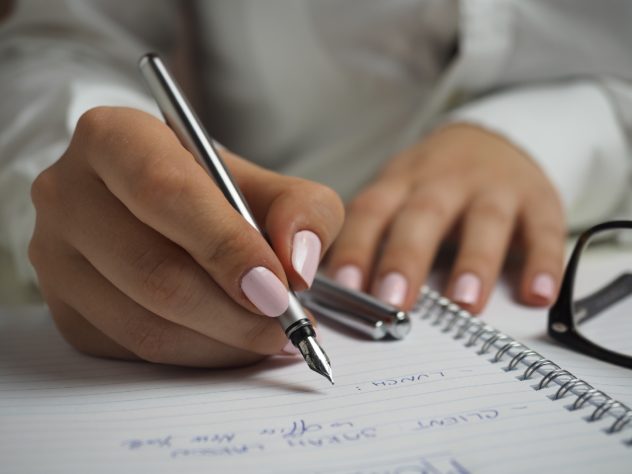Vocabulary:
- keyboarding /KEE-bawrd-ing/
- tactile /TAK-til/
- verbatim /ver-BEY-tim/
- documentation /dok-yuh-men-TEY-shuhn/
- reap /reep/
[noun] – the act of typing using a keyboard
We need to take typing tests to further improve our keyboarding skills.
[adjective] – tangible, of or connected to the sense of touch
Tactile feedback is a must in order to properly check the quality of the products.
[adjective] – using exactly the same words as were originally used
Try to take down verbatim notes during the meeting as much as possible.
[noun] – official or legal documents that are needed in order to prove something
It seems that the documentations Lilian provided were not enough to support her claim.
[verb] – to obtain or retrieve something as a result of your own actions
Let’s keep improving our skills for us to reap more rewards and benefits.
It’s no surprise that the majority of people nowadays use computers, smartphones, and tablets to take notes. They are quicker and yield less errors, and certain digital communication tools help us improve. Keyboarding will continue to evolve over time, too, but research shows that the pen is indeed mightier than the sword, or electronic devices.
What does this mean? First, handwritten notes are powerful tools to improve the brain’s capacity to retrieve information, known as the encoding effect. Second, taking notes by hand forges an “external memory storage”: your notebook. Writing on paper also provides tactile feedback to the brain since we write the actual letters, which keyboarding cannot do. Let’s discuss more about the benefits of handwriting.
According to researchers, keyboarding involves taking verbatim notes without processing the information written, which includes the copy and paste strategy. This is otherwise known as “non-generative” note-taking. Handwriting, on the other hand, exercises our brain to function instead of mindlessly typing out words. Summarizing, paraphrasing, organizing, concept mapping — in short, we develop a deeper understanding of whatever we write.
What about visual learners? Do they also benefit from handwriting? The answer is yes. Florence Nightingale, a British nurse, used a pie graph to represent the details of modern medicine alongside her documentations. People can show their knowledge through a series of drawings accompanied by descriptions. Remember your math and science lessons? They use figures for better understanding of formulas.
Students are still encouraged to take notes using pen and paper during online classes during this pandemic. Don’t solely rely on computers and put those pens and paper to good use. Sometimes, using the old-fashioned way reaps superior results.
What does this mean? First, handwritten notes are powerful tools to improve the brain’s capacity to retrieve information, known as the encoding effect. Second, taking notes by hand forges an “external memory storage”: your notebook. Writing on paper also provides tactile feedback to the brain since we write the actual letters, which keyboarding cannot do. Let’s discuss more about the benefits of handwriting.
According to researchers, keyboarding involves taking verbatim notes without processing the information written, which includes the copy and paste strategy. This is otherwise known as “non-generative” note-taking. Handwriting, on the other hand, exercises our brain to function instead of mindlessly typing out words. Summarizing, paraphrasing, organizing, concept mapping — in short, we develop a deeper understanding of whatever we write.
What about visual learners? Do they also benefit from handwriting? The answer is yes. Florence Nightingale, a British nurse, used a pie graph to represent the details of modern medicine alongside her documentations. People can show their knowledge through a series of drawings accompanied by descriptions. Remember your math and science lessons? They use figures for better understanding of formulas.
Students are still encouraged to take notes using pen and paper during online classes during this pandemic. Don’t solely rely on computers and put those pens and paper to good use. Sometimes, using the old-fashioned way reaps superior results.
Comprehension Questions:
- Who is the British nurse that used a pie graph to demonstrate the details about modern medicine?
- What is the encoding effect?
- What does handwriting do to our brains for us to have a better understanding of what we write?
- What is considered an “external memory storage” when writing by hand?
- What do people use nowadays to take down notes?
Discussion Questions:
- Do you agree that handwriting is a better way to understand the notes a person has taken? Kindly share your thoughts about this.
- If illustrations do not exist to support certain formulas (such as geometry), how would it affect the students learning the subject?
- Should students taking online lessons still take notes with pen and paper? Why?
- What other benefits do you think handwriting has?
- Which do you prefer, saving notes on your computer, smartphone, or tablet, or keeping a notebook? Why?
